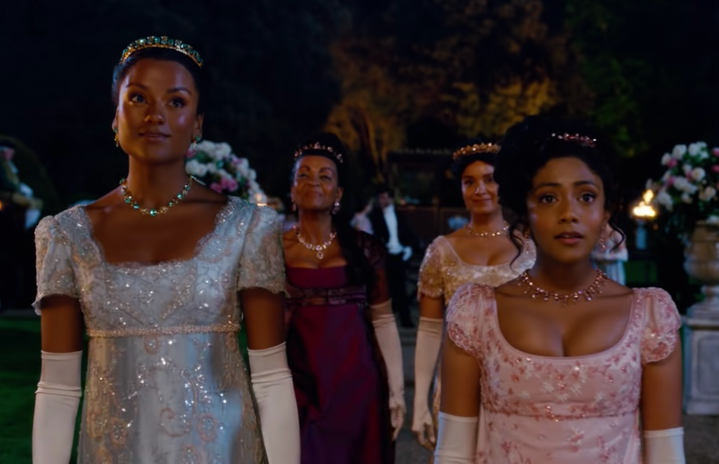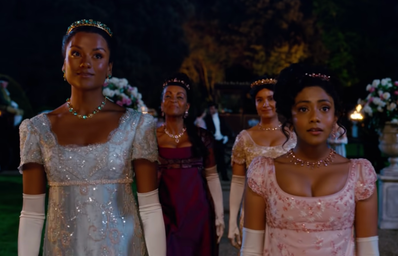Edited By Mohan Rajagopal
Bridgerton, Netflix’s exquisite historical romance series produced by Shonda Rhimes, has grown to be as contentious as it is popular, a lot like the prim society debutantes at its core. Since its first season came out, it’s been quite clear that Shonda Rhimes took full creative liberty over the Regency-era drama. The show has a lot to offer, including an alternate universe ruled by a Black Queen as opposed to actual history, a slew of anachronisms to go with a lusty love tale, classical versions of modern pop songs, magnificent cinematography, and an intricately plotted romantic storyline for each season.
More specifically, the cast of the show is as diverse as it can be. It features a mix of brown, black and white actors in prominent roles. One could say that because the show portrays an alternate historical universe, it contains a colourblind depiction of society. However, there is a significant issue in terms of reflecting the culture of this diverse ensemble and addressing race in general. There are several inconsistencies concerning how the show develops its black and brown characters. That being the case, I’d like to point out the good things and the bad.
To begin with, in Season 1, Bridgerton questions how a diverse nobility could have existed during a period when the majority of Black and brown people in Britain were forced into domestic service. However, both the magnitude and level of acceptance of those persons depicted in Bridgerton are historically inaccurate— intentionally so. The how of it is addressed explicitly by a major Black character later in the show wherein she mentions the merging of the two racially different communities due to love and how that is helping the black community. Aside from historical accuracy, one of the show’s creators stated that they intended Bridgerton to “represent the reality that we live in today.” Julia Quinn, the series’ author, praised the casting decision as well, stating that “it’s really essential.” She claimed that the inclusion of Queen Charlotte – an actual historical queen thought to have had “significant African ancestry” – in the show was a powerful gesture that may help reinvent what the Regency period could have been like. Moreover, the show’s casting diversity is notable, not only in Black aristocratic characters like the Duke of Hastings and Lady Danbury but also in the entrepreneur Madame Genevieve Delacroix and the working-class couple Will and Alice Mondrich. They are all crucial to the show’s interpretation of early 1800s London’s complicated social caste system.
Unfortunately, despite its finery, there are snags in the show’s colourful fabric that simply cannot be ignored, particularly the negative stereotyping of its Black characters. Firstly, there is very little indication of real-world racism and extreme disregard for slavery. In addition, the characters’ race is ignored throughout the show, apart from a few references in dialogues in which they use words like ‘us’ and ‘them’ in relation to white people. Race can’t not be important when the universe these characters live in is shaped by racism. And since slavery existed, race cannot be ignored. Having Black individuals saunter about in the background does not eliminate this, and it is insufficient. Also, most of the speaking roles belong to white characters and all the Black characters with speaking lines have negative attributes associated with them that place them at odds with the white characters, due to which they suffer from a lack of context outside their relationship to white characters.
Moving on, Season 2 introduces us to Indian characters, the Sharmas, who are portrayed in the same chaotic, yet beautiful manner, with a few victories but also flaws, most of which are due to improper cultural depiction. Simply, what went right was how the show accurately managed to represent the roots and traditions of Indian culture. The makers of the show rightfully credit India as the birthplace of surgery and discuss how the western world has a lot to learn from commendable Indian medical practices. Besides, the scene with the haldi ceremony, which is a widely recognised pre-wedding ceremony in Indian weddings wherein a turmeric paste is applied to the bride’s skin as a beauty pack, was refreshing to see because it is not widely known, at least not through the media. Lastly, the subtle inclusion of Indian jewellery through Kate’s bangles and Edwina’s jhumkas was delightful yet impactful since it represented Indian artistry. In addition to that, the oiling of hair was also an intimate touch.
Despite all of that, the main issue lies within how all-over-the-place the ethnic aspects of their identities are. Anyone in the know understands that the Sharma family does not neatly fit into a South Asian or Indian convention. Their surname is upper-caste north Indian, but Kate and Edwina refer to their father as Appa, which is Tamil for father. The family speaks Marathi and Hindustani, which may reflect their Bombay heritage, but Kate refers to Edwina as “bon”, a Bengali word for sister. Kate despises English tea in favour of masala chai, which she makes with pour-over hot water and while this reflects India’s love for tea, it does not align with the timeline of when masala tea was introduced to India. In a nutshell, it’s a pan-Indian jumble that’s gloriously ridiculous. Instead of striving to impose authenticity on a plotline and environment that necessitates suspended imagination in the first place, we get to experience mainstream diversity and frivolity simultaneously. Lastly, the show failed to acknowledge the impact of British colonialism and did not explore this aspect at all.
Nonetheless, it’s fascinating to watch Shondaland’s efforts to embrace representation, as well as how the show juxtaposes many racial identities and cultures within the Regency era. As a result, the black and brown audience might experience a considerably broader range of frustration as well as delight.


